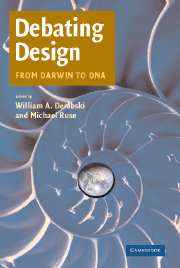Book contents
- Frontmatter
- Contents
- Notes on Contributors
- Debating Design
- INTRODUCTION
- PART I DARWINISM
- PART II COMPLEX SELF-ORGANIZATION
- PART III THEISTIC EVOLUTION
- PART IV INTELLIGENT DESIGN
- 17 The Logical Underpinnings of Intelligent Design
- 18 Information, Entropy, and the Origin of Life
- 19 Irreducible Complexity
- 20 The Cambrian Information Explosion
- Index
- References
17 - The Logical Underpinnings of Intelligent Design
Published online by Cambridge University Press: 05 June 2012
- Frontmatter
- Contents
- Notes on Contributors
- Debating Design
- INTRODUCTION
- PART I DARWINISM
- PART II COMPLEX SELF-ORGANIZATION
- PART III THEISTIC EVOLUTION
- PART IV INTELLIGENT DESIGN
- 17 The Logical Underpinnings of Intelligent Design
- 18 Information, Entropy, and the Origin of Life
- 19 Irreducible Complexity
- 20 The Cambrian Information Explosion
- Index
- References
Summary
RANDOMNESS
For many natural scientists, design, conceived as the action of an intelligent agent, is not a fundamental creative force in nature. Rather, material mechanisms, characterized by chance and necessity and ruled by unbroken laws, are thought to be sufficient to do all nature's creating. Darwin's theory epitomizes this rejection of design.
But how do we know that nature requires no help from a designing intelligence? Certainly, in special sciences ranging from forensics to archaeology to SETI (the Search for Extraterrestrial Intelligence), appeal to a designing intelligence is indispensable. What's more, within these sciences there are well-developed techniques for identifying intelligence. What if these techniques could be formalized and applied to biological systems, and what if they registered the presence of design? Herein lies the promise of Intelligent Design (or ID, as it is now abbreviated).
My own work on ID began in 1988 at an interdisciplinary conference on randomness at Ohio State University. Persi Diaconis, a well-known statistician, and Harvey Friedman, a well-known logician, convened the conference. The conference came at a time when “chaos theory,” or “nonlinear dynamics,” was all the rage and supposed to revolutionize science. James Gleick, who had written a wildly popular book titled Chaos, covered the conference for the New York Times.
- Type
- Chapter
- Information
- Debating DesignFrom Darwin to DNA, pp. 311 - 330Publisher: Cambridge University PressPrint publication year: 2004
References
- 4
- Cited by



